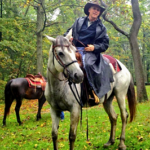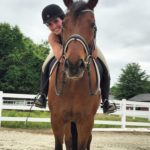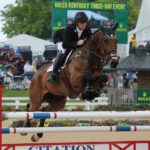
When I interviewed Yvonne Barteau, international dressage competitor, trainer, and author of Ride the Right Horse: Understanding the Core Equine Personalities and How to Work with Them, I was going through a very difficult time with my dressage horse, Baleno.
To be truthful, our five-year relationship has been less than harmonious. He’s an auction horse, likely sold because he bombed out in the jumper ring despite incredible physical talent. He’d been in a large sale barn, treated as one of many with different grooms and little personal attention.
I bought Bee (as I call him) because when I’d ridden him he seemed quiet, steady, and even a bit unresponsive. I liked that. To me, it meant reliability in the show ring. While the other horses were flying around in the auction arena, frightened of flapping tablecloths, and the auctioneer’s table with its flyers and amplifier and accoutrements, Baleno trotted around confidently.
When Bee came home with me, he spent the first few hours establishing himself as master of my already-established herd of two. Over the next months, he also established himself as master of me, to be honest. He’s big, he’s prone to kicking out when angered, he liked to scrape my leg against the fence, and he’d stop and hop up and down whenever the question I was asking him got a little challenging.
Personality Insights
- Learning about different horse personality types can help us learn to work most effectively with our horses.
- The horse’s personality should guide everything we do.
- Stress brings out the true personality in all of us, both human and horse.
- Certain human personality traits match well with some horse traits, and make it easier to get along and move forward in partnership.
Sometime during that first year, Bee suddenly decided he wasn’t-no way, no how-going to load in the trailer. This was not a fear-related reaction. He’d loaded many times and ridden calmly. There had been no mishaps. It was mysterious to me, but somehow he’d learned to take advantage of a weakness. I’d never owned a horse with loading troubles and had no idea how to fix the problem.
One of the great advantages of writing about horses is the opportunity to talk with insightful professionals. While my discussion with Yvonne Barteau was a professional assignment, the benefits of the interview-as well as reading her book beforehand-gave me new insight into my own relationship with horses, and Bee particularly.
How It All Started
Yvonne wrote her book, Ride the Right Horse: Understanding the Core Equine Personalities and How to Work with Them, in only a few months. The book evolved from a system she and her husband, Kim, developed while working first at Arabian Nights Dinner Theatre in Orlando, Florida, and later at the training facility where, at any given time, they have 40 to 60 horses in training.
At the dinner theatre, equine performers must learn to bear enormous distractions-thousands of busy, noisy audience members, flowing costumes, spotlights, music, fire, running people, etc. The horses not only have to learn to keep their wits, but they also have to perform in the shows. Tricks, liberty work, and haute école dressage movements are expected of them. That environment tests any horse’s personality, and under such stress, their real natures tend to show through, Yvonne says.

Four Core Personality Types
Yvonne categorizes horses into four core personality groupings: fearful, social, aloof, and challenging. Yvonne chose her language, she says, because the words are familiar and give us a quick understanding of each type.
In each of these groupings, a horse can exhibit a great deal of that personality trait or less so. For example, on a scale of 1 to 10, a horse might be a 3, meaning the trait is exhibited only mildly. Or he might be a 7, which means he strongly shows those elements of his personality.
In addition, some horses can exhibit a combination of two different traits, with one usually being dominant-and more likely to show through during times of stress. Yvonne uses her treasure trove of real-life anecdotes-and she has plenty-to explain the different personalities and how she worked with and trained each one.
The horse’s personality, Yvonne contends, should guide everything you do with him, from training to barn life to the horses he’s turned out with.
Too often, says Yvonne, an individual has his or her first experience with a horse as a young person. For example, if your first horse exhibited an aloof personality, you learn how to deal with that particular type. Then when you get a horse later on, you treat the new horse exactly as you treated your childhood horse, even though the new one may have an altogether different personality.
“What you find in this situation is that nothing you did before works with your new horse,” says Yvonne. “Sometimes you don’t really know, for example, that you are a fearful rider until you come across a fearful horse.” Then the situation escalates.
Building Understanding
Understanding horse personalities, then, can help you to understand how to work with each one. While it may seem complicated, a horse’s personality merely dictates the dosage and timing of the aids, Yvonne says. “With a challenging horse, you say, ‘you will do it.’ The trainer/rider has to be able to adapt the aid. For example, aloof horses will studiously ignore you. Social horses might clown around. Maybe the horse acts fearful, and the person starts acting fearful and triggers the horse’s more fearful personality.”
“With challenging horses, you have to worry about over-handling the horse because they’re confrontational,” Yvonne continues. “They’ll argue about getting in the trailer. When you’re trailering an aloof horse, he’s not even going to look at the trailer. So how are you going to drive a horse into the trailer when he’s not even looking at it?”
Yvonne recounts, “I knew a woman who owned a mare that she considered the best horse ever. She bred the mare and raised the filly. But they were struggling along at training level dressage. The woman said to me, ‘I think she’s a lot like her mother,’ and she was blaming herself for not being able to train the horse effectively.”
What was really happening, Yvonne says, was that the woman was treating the young horse exactly as she’d treated her mother, even though the two had very different personalities. “I told her, ‘You have a challenging horse; this mare has been training you for 13 years. The mare knows you don’t know her.’ The mare knew that I knew her. And then she was almost glad to be supervised.”
Tested by Stress
Most horses won’t show the extremes of their personality traits unless they’re under stress. Take them out of their element, for example, and fearful horses become much more spooky and flighty; challenging horses may become bossier, and aloof horses may “just check out.”
As a rider and trainer, how you handle your horse in these situations can either underscore or derail his innate reactions. A fearful rider with a fearful horse offers her horse no reassurance and trust that everything will be all right. Instead, the horse senses the rider’s fear, and his own fear escalates.
A social horse that arrives at a horse show or trail ride will think it’s one big horse party, and you’ll have to work to get his attention. “If your challenging horse doesn’t answer a big question, go back and do small things,” says Yvonne. The success will boost his confidence and allow you to move forward with training.

Getting to Know You
While training systems can provide a framework, Yvonne notes that riders and trainers who follow step-by-step instructions can quickly lose confidence when the training method doesn’t work as it’s supposed to.
“A lot of times, people will focus on the steps of training rather than getting to know their horses,” says Yvonne. Instead, evaluate how your horse reacts to each step, and adapt your training methods according to his individual personality.
Social horses must be made to focus, and understand and respond to aids one at a time, notes Yvonne. Aloof horses have to tune in- if your aloof horse puts an ear on you and asks, “What is it?” carry on with your request. If he doesn’t respond, intensify the aid until he does. Challenging horses need more direction than reassurance. Never rush a fearful horse; instead, introduce him to new things slowly, confidently, and methodically.
Understanding Bee
Take Bee and me as an example. During the first year of our relationship, we spent a lot of time arguing. We argued about getting in the trailer. We argued about cantering. We argued about leg yields.
I don’t consider myself a passive rider or trainer, but the first horse I trained myself was tractable, playful, and social. I asked; he responded. I expected the same from Bee.
In Yvonne’s methodology, I’d characterize my first horse as an aloof, social horse. I nicknamed him Ferdinand the Bull, because, like the bull in the children’s story, he preferred to eat alone under the cottonwood tree than socialize with his pasture mates or go to work. Nonetheless, he liked to be fussed over and loved to gently tug on my sweatshirt hood.
Conversely, Bee immediately became the head horse in the herd. What Bee does, everyone else follows. The more demanding I got with Bee, the more he argued with me. He wasn’t particularly interactive with me except at dinnertime, when he kicked the stall wall until he got fed.
Bee is an aloof, challenging horse. I couldn’t put words to his personality until I read Yvonne’s book. But once I’d finished it, I knew without a doubt where I’d gone wrong with Bee’s training, his trailering, and his life on the farm.
Before reading Yvonne’s book, I’d often characterize Bee as a “pony in a horse body,” because he could be stubborn and shut down. At times, I’d apply an aid and get zero reaction. Yvonne notes that over-facing a challenging horse is a bad idea. I can think of dozens of situations where I asked my talented dressage horse to do more than he was able or ready to do.
Matching Horse with Human
Just as horses have personality types, certain human personality traits match horse traits, while others may need more help to get along and move forward in their partnership. If you’ve ever been through the Myers Briggs Type Indicator test, you’ll have an idea how Yvonne’s system works when you add people to the equation.
When I was younger, I worked in a museum’s creative department. The staff had a hard time interacting. We brought in a consultant, who administered the Myers Briggs test to all of us. It turns out that the accounting and business office was made up of detail-oriented, introverted people, while the creative department was full of big-thinking extroverts. We creatives learned that our social, noisy, and at times unorganized work style drove the head-down pencil-pushers nuts. No wonder we had a hard time getting along!
The same is true of horses. If you love cuddling and want your horse to acknowledge you with a nicker every time you come to the barn, you may have to learn to draw out an aloof horse, or reassure a fearful one, since these personalities aren’t naturally inclined to socialize.
Yvonne encourages riders to understand themselves and their personality types. In Ride the Right Horse, she suggests riders take the Myers Briggs Type Indicator (available online) and apply that self-knowledge, along with honest self-assessment, to your own horse training and riding style.
If you’re a fearful rider with an introverted personality, a fearful, aloof horse will require that you move out of both of your comfort zones to work together. You’ll need to be the leader in that relationship. To do so, you’ll have to overcome both your fear and your introversion.
For myself, Bee’s challenging-aloof nature doesn’t completely match my own style. Although I consider myself a strong personality, I’m a bit of a softie when it comes to animals. Bee learned this quickly, and during the past three years I’ve had to work hard to be such a strong horse’s leader.
We’re making progress, as I’ve learned not to push him too hard, to work in much smaller steps, and to reward him profusely when he does respond. Even though he seems not to care (his aloof side), he actually responds very well to reward in the form of affection.
“We’re all different,” says Yvonne. “It’s good to know ourselves, make a plan that works that is in reference to our system, and pay attention to personality all the time in training. For many people, understanding their horses’ personalities could be the missing link.”







